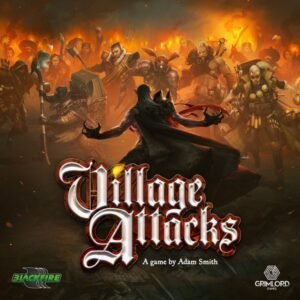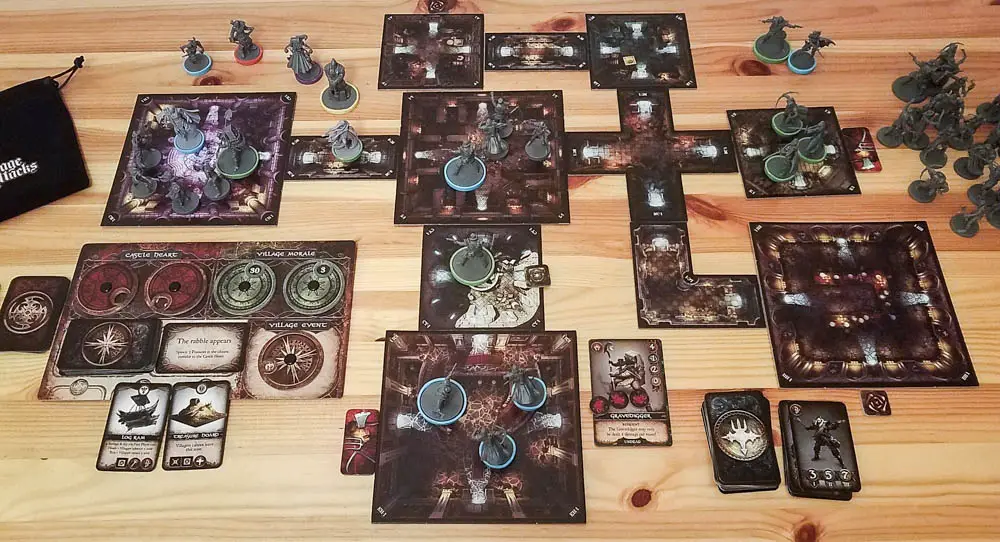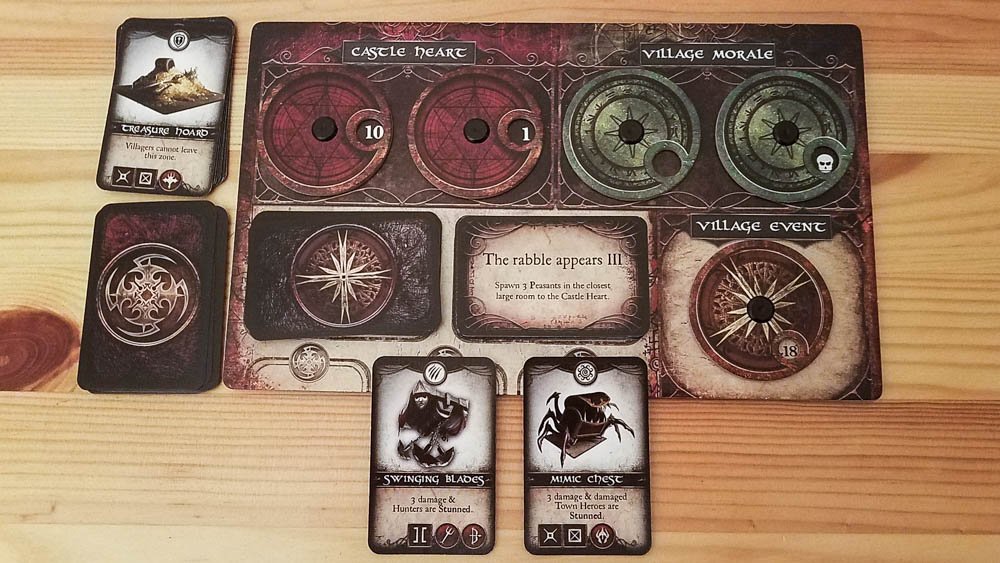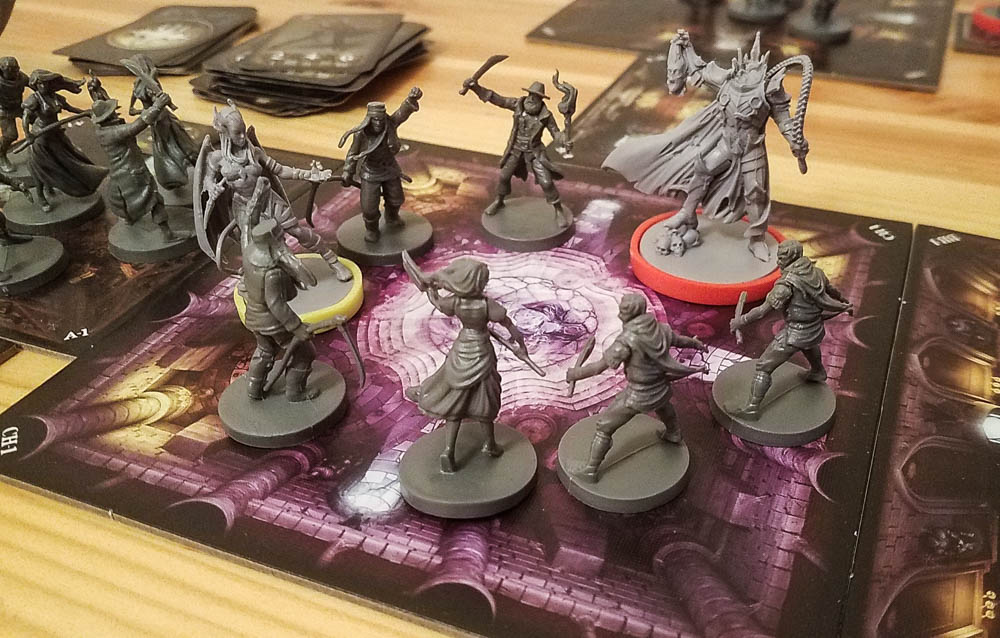Village Attacks Review
Year: 2017 | Players: 1-5 | Minutes: 30+ | Ages: 14+
This Village Attacks review was made after playing through nine missions (some multiple times).
What is Village Attacks?
Village Attacks is a cooperative tower defense game in which you play as powerful monsters who are attempting to keep local villagers from exorcising you from your castle. The game was designed by Adam Smith and is published by Grimlord Games.
Village Attacks Gameplay
In Village Attacks, you’ll be using your monsters to move around your castle and kill some villagers to bring the village morale down. The villagers are attempting to destroy the Castle Heart (the purple room), which is the only way for them to get rid of all of the monsters for good. Every mission in Village Attacks has unique rules and objectives, but you’ll always lose if the villagers destroy the Castle Heart.
There are three types of villagers that you’ll face in Village Attacks: Peasants, Hunters, and Town Heroes. The peasants can only attack in the rooms they’re in, but they show up in larger groups. The hunters can attack in their own rooms and in adjacent rooms. The Town Heroes, the toughest villagers, have unique stats and abilities. Town Heroes and hunters prioritize attacking certain types of monsters and the peasants are always focused on doing damage to the Castle Heart.
Each round has three phases:
- Monster Phase – Each player gets to roll the six dice and use those dice to perform actions. If you roll three or more of a kind, you can choose to reroll those dice. You can use the dice to perform melee and ranged attacks, to use magic for healing while in the Castle Heart, to block, and to retaliate when villagers attacks you. The worst side of each die is the one that allows villagers to move closer to the Castle Heart. You can also use the dice to activate your special abilities, to buy and place traps around the castle, or you can even save them for future rounds. Every time you kill a villager, you’ll gain experience and you can use your experience to get new abilities for your monster.
- Villager Phase – There’s a Village Event Wheel that advances at the start of this phase, potentially triggering an event (always bad). Each villager in the castle will first attack if they can and then they’ll move one room closer to the Castle Heart. After that you’ll draw one card for each spawn point around the castle and place those types of villagers in the rooms.
- Clean-up Phase – Expired traps and tokens are removed, a new trap is made available, and the first player coin is passed.
Every time you kill a villager, you’ll lower village morale on the Game Overview tile. When villagers do damage to the Castle Heart, you’ll lower that dial. You’ll win if you’re able to complete a mission’s objectives and you’ll lose if the Castle Heart dial ever reaches zero.
You can make the game more challenging by using the Day and Night dice, alternating day and night rounds. The day rounds are tougher because you can’t gain experience and because the Day die only has blank and Villager faces. You’re more powerful in the night rounds, though, since the Night die gives you guaranteed attack results.
Hopefully that gives you a feel for how the game plays. For more info, check out the official Village Attacks rulebook (PDF).
[the_ad_group id=”1052″]
Pros and Cons
Pros
- I bought Village Attacks because the theme seemed very cool and different, so I’m very happy that it did end up being a very thematic game. The villagers will attack you, but they REALLY want to get to the Castle Heart to destroy every monster in their town, so they’ll attack then run right past you. It really does make you feel like you’re monsters protecting your home.
- Dozens of villagers can be in your castle at one time, giving the game a true “horde mode” feel during most missions. In fact, we continued to play even after we had beaten a couple of the missions just to see how many villagers we could clear out, which was a lot of fun.
- I like that there are multiple miniature sculpts for each type of villager. That helps to make it feel like a bunch of different people have come together to take down your castle. Plus, all of the miniatures look great.
- The traps are really cool. They give you and your teammates more interesting tools to use each round. They can potentially get you out of trouble, but you have to figure out where and when to place them since any of the villagers can trigger them at the end of rounds.
- I’m also a big fan of the retaliate action, especially with the bigger monsters like the Dullahan who have more health. Sometimes it’s worth taking some damage to clear out some villagers, so it’s nice to have more than just a simple block as a defensive action.
- Each monster plays differently thanks to those unique sets of abilities and the dice slot layouts that each one has.
- It’s obvious that the designer put a lot of work into all of these missions. They all play quite differently, giving you a variety of puzzles to solve. My favorite so far is a mission that has the Town Heroes attempting to capture monsters and escape.
- I think the game scales pretty well. The rules were made for three characters, but all you have to do is add/subtract the amount of villagers you spawn each round for more or fewer characters. You can’t cover as much ground with two characters, but I still like that character count because the games are a bit more challenging. I’ve played games with two, three, and four players/characters, and had a good time at each of those counts.
Cons
- There really aren’t many ways to mitigate bad dice rolls. You can save some dice for future turns, but that’s not going to mean much to you when you need some help clearing out some villagers right now. It feels really bad when you can’t do much on your turn, which can happen multiple times per game.
- There’s plenty of cooperation in Village Attacks, but I would have liked to have seen more cooperative actions. For example, I think it’d be great if you could give one or more of your dice results to a teammate, maybe as an “Inspire” action.
- Some of the monsters have much better abilities than others. For example, the Lich starts out with a Soul Arrow that can hit any villager in the castle, which is always awesome, but then you have Succubus’ starting ability to use the villager dice to move villagers that are around her, which is very situational. I think most people would rather have the Lich.
- It’s pretty disappointing that four of the missions in the base game’s rulebook require you to have one of the expansions. In my opinion, base games should never include rules – and, in this case, full scenarios – that require components from expansions.
- The rules reference on the back of the rulebook is great, but I think it should have been on a separate sheet of paper or a card since the missions (and their unique rules) are inside of that same rulebook.
Final Thoughts
Village Attacks is a fun and unique tower defense game with a great theme. I do have some issues with it, but at the end of the day my group has had a blast playing through the missions, so I can’t complain too much. There’s a good amount of tension in the game as you try to roll well and deal with all of those groups of villagers that come steamrolling in, and it has a very nice look to it.
If you like a lot of theme in your games, if you’re a fan of tower defense games, and/or if you’re like me and have always enjoyed horde modes in games, then you should definitely check out Village Attacks.
Village Attacks Links
BGG | Kickstarter | Grimlord Games
Thanks for taking the time to read our Village Attacks review!
Be sure to also take a look at our Best Co-op Board Games list and other rankings.
To stay updated on all things cooperative board games and card games, follow us on Facebook and X.





